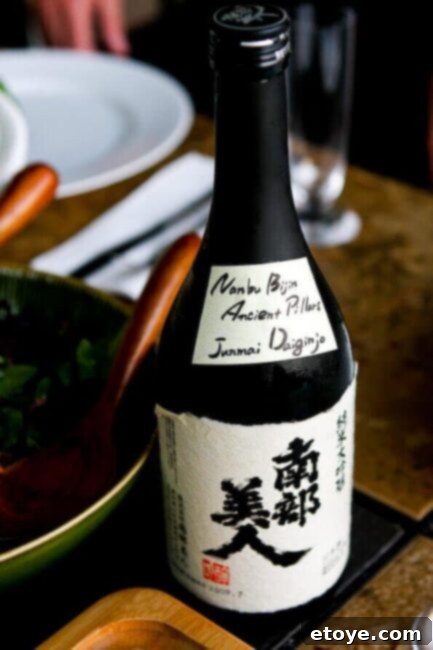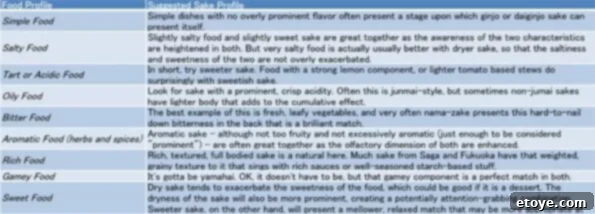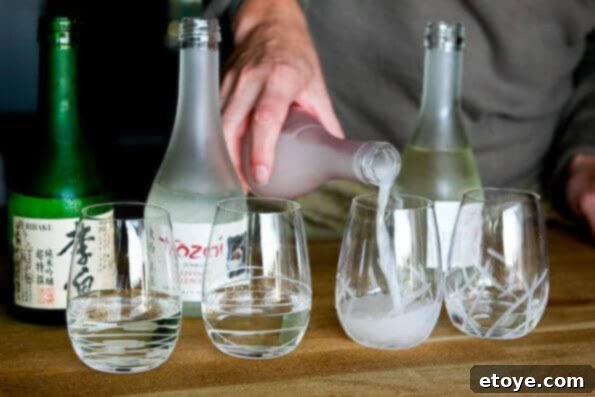As a passionate admirer of Japanese artisan sake, I’ve long harbored the desire to share an insightful article about the nuanced world of sake and food pairing. However, I readily admit I’m not the expert in this intricate field. Imagine my delight, then, when John Gauntner, the esteemed author, instructor, and publisher behind one of the most comprehensive online resources for Japanese sake, SakeWorld.com, graciously offered to pen a piece for my readers. I practically did a back-flip with excitement! The stars aligned even further when Morgan from Vine Connections, a former client of mine, arrived bearing a generous case of diverse sakes for us to explore. Naturally, such an occasion called for a celebration, so I invited my wonderful friends, Michael, Debbie, and Barry, to join in the festivities. Our culinary spread was intentionally non-Japanese, which proved to be an ideal choice. This allowed us to truly experience firsthand how the clean, crisp, and elegantly complex profiles of Japanese sake harmonized exquisitely with a variety of global cuisines. Highlights of the evening included surprising yet delightful pairings with artisanal cheeses, rich manicotti, succulent smoked wild boar, and freshly baked homemade bread. It was a testament to sake’s incredible versatility, a journey I’m thrilled to share with you. ~Jaden

by John Gauntner
Let me state this unequivocally: sake offers an astonishing breadth of potential for food pairing, rivaling that of wine. This isn’t mere hyperbole; it’s a truth rooted in sake’s unique characteristics, and the underlying principles for successful pairing are remarkably similar to those governing wine.
Of course, like any beverage, sake has its distinctive attributes that define its role at the dining table. Sake is, by nature, often more subtle and nuanced; it typically possesses a much smaller presence or “footprint” on the palate compared to many wines. It tends to be more demure, more delicate, allowing the food to shine without being overshadowed. Significantly, sake generally exhibits a lower overall acidity than wine and, crucially, contains no tannins. These distinctions, while perhaps limiting it in certain niche scenarios, simultaneously unlock a vast and exciting world of pairing possibilities that wine simply cannot achieve.
But let me dispel a common misconception right here: sake is emphatically NOT limited to Japanese food, nor even exclusively to Asian cuisine. Banish that thought from your mind! While sake certainly finds its ancestral home and perfect harmony with traditional Japanese dishes, its adaptability extends far beyond those borders. Naturally, exceptionally strong flavors – whether overly spicy, excessively rich, or intensely hot – can overwhelm sake’s delicate profile. However, once you navigate around these obvious mismatches, you’ll discover that a vast spectrum of Western and global cuisines not only works well with sake but often creates truly sublime culinary synergies.

The art of sake and food pairing is far from rocket science; it operates on principles akin to those guiding wine pairing. The core idea is to seek harmony through either comparison or contrast. You look for similarities in flavor profiles, textures, or aromatic notes that amplify both the food and the sake, or you identify intriguing contrasts that create a delightful tension and balance. When these elements align perfectly, you achieve that coveted synergy where both the dish and the drink are elevated, becoming more enjoyable together than they would have been in isolation.

It’s interesting to note that, traditionally, in Japan, sake and food pairing haven’t been approached with the same precise, almost scientific methodology as wine and food pairing in the West. Certainly, sake has always been enjoyed alongside meals in Japan. However, its historical role was more one of support; it played a refined background role, enhancing the meal without drawing undue attention to itself. The common adage was “Ryori ni jama shinai,” which translates to “sake that does not interfere with the food.” While this mindset is gradually evolving, particularly as more global culinary influences permeate Japan and sake gains international recognition, this historical perspective often still shapes modern traditional thinking.
Unlocking the Secrets of Sake Pairing: What to Look For
So, when embarking on your sake pairing journey, what specific elements should you consider? The answer is multifaceted, encompassing a wide array of sensory attributes. You’ll want to assess the sake’s sweetness or dryness, its aromatic profile which can range from vividly fruity (like apple, pear, melon, or banana) to earthy, nutty, or even subtly floral. The flavor spectrum is equally broad, from the clean, pure essence of rice to more complex herbal, mushroom, or savory notes. Beyond flavor and aroma, structural components are vital: consider the sake’s volume or body, its inherent acidity (even if lower than wine), its texture (silky, crisp, viscous), and the length of its finish – how long the flavors linger on your palate.
One more crucial element, a true game-changer in sake and food pairing, is umami – that elusive yet profound savory taste, often referred to as the “fifth basic taste.” Sake, especially premium varieties, is naturally rich in umami due to the brewing process and its amino acid content. Without sufficient umami, sake can feel too simple, lacking depth. Conversely, an excessive amount of umami in both sake and food can become cloying or overwhelming. However, finding the perfect balance and matching the umami presence in sake with a dish is a powerful and often magical pairing principle. This synergy creates a satisfying mouthfeel and amplifies the deliciousness of both components, making them sing in harmony.


Where Sake Truly Shines: Outperforming Wine
There are a number of specific culinary situations where wine often struggles to find a perfect match, but sake steps in as the near-perfect companion. Vinegar-laden dishes are a prime example, including many vibrant leafy green salads dressed with vinaigrette. The acetic acid in vinegar can clash harshly with the tannins and higher acidity in many wines, leaving an unpleasant metallic taste. Sake, with its lower acidity and lack of tannins, gracefully navigates these flavors, refreshing the palate without conflict. Similarly, soy-tinged foods, which are becoming increasingly prevalent in global cuisines beyond Asia, find an ideal partner in sake. The complex, savory notes of soy sauce, often rich in umami, resonate beautifully with sake’s own umami profile, creating a profound depth of flavor that many wines cannot achieve without being overpowered. And when fresh oysters are on the table, sake asks for no quarter from wine; its clean, saline, and sometimes subtly fruity or mineral notes are an exquisite match, enhancing the brininess and delicate texture of the oysters without competition.
The Importance of Tasting: Beyond the Label
One crucial distinction to remember when approaching sake pairing is that you cannot rely on the label alone to dictate a pairing, as you often can with wine. While a wine label might reliably indicate a certain region’s style or a grape’s characteristic flavor profile, this is not consistently true for sake. Why? Sake flavors and aromas exhibit significant variation, not only across different regions but also across various grades and brewing methods within the same region. A Junmai from one brewery might taste vastly different from a Junmai from another, even if they share the same official classification. The label alone simply won’t provide enough information to guarantee a successful pairing. To truly understand a sake’s character and how it will interact with food, you absolutely must taste it first.
Embrace Experimentation: Sake’s Forgiving Nature
Fortunately for the adventurous palate, it’s remarkably difficult to create a truly disastrous mismatch with sake. Even if a pairing isn’t absolutely perfect, sake’s generally gentle and nuanced profile offers a generous amount of leeway. Its ability to cleanse the palate and harmonize rather than dominate means that even less-than-ideal pairings rarely result in an unpleasant experience. This forgiving nature makes sake an excellent beverage for exploration and experimentation. So, shed any apprehension and feel completely free to try different sakes with various dishes. The journey of discovery is part of the fun!
To help you get started, consult the charts below for a few suggested pairing strategies. You can begin by considering the profile of the sake you’re drinking or the characteristics of the food you’re eating. These are merely starting points and illustrative examples; the fundamental principles will empower you to branch out and create your own unique and appealing pairings. Dive in, experiment for yourself, and discover just how incredibly food-friendly and versatile sake truly is across the culinary landscape.
Sake – Food Pairing Chart – Starting with Sake Profile
(I’m working on getting these charts bigger and downloadable)

Sake – Food Pairing Chart – Starting with Food Type


Further Resources for Japanese Sake Enthusiasts
To deepen your understanding and appreciation of Japanese sake, explore these valuable resources:
- Understanding Japanese Sake Grades: Delve into the classifications and categories of sake.
- How Premium Sake is Made: A detailed look into the intricate brewing process.
- How to Read Sake Labels: Navigate the essential information on sake bottles.
- How to Serve Sake: Learn the proper techniques for enjoying sake at its best.
- Sparkling Sake: Explore the effervescent and growing world of sparkling sake, including “sake2me.”
- Sake World: John Gauntner’s definitive website, offering a wealth of information on sake.
- esake.com: An extensive online resource with over 350 pages and 400 photos, providing in-depth knowledge.
- The Sake Notebook: Discover a curated list of 250 recommended Japanese sakes.
- Sake’s Hidden Stories: An insightful ebook by John Gauntner, uncovering fascinating tales of sake.
